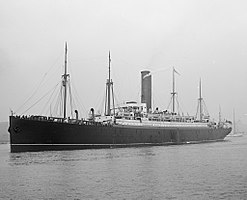RMS Saxonia (ship, 1900)
|
||||||||||||||||||||||
|
||||||||||||||||||||||
|
||||||||||||||||||||||
|
||||||||||||||||||||||
|
||||||||||||||||||||||
The RMS Saxonia was an ocean liner put into service in 1900 by the British shipping company Cunard Line , which was used in passenger and freight traffic from Liverpool via Queenstown to New York and Boston as well as into the Mediterranean . In the First World War the ship served as a troop transport . It was decommissioned in 1924 and broken up in 1925.
The ship
The keel for the steel steamship RMS Saxonia was laid on November 22nd, 1898 with hull number 339 at the John Brown & Company shipyard in Clydebank , Scotland . The Saxonia was 176.78 meters long, 19.57 meters wide and had a side height of 12.71 meters. The Saxonia was powered by eight-cylinder steam engines with vertical quadruple expansion, which allowed a top speed of 16.59 knots (29.6 km / h). The machine output was 10,000 PSi .
She was the sister ship of the RMS Ivernia , which was completed by Swan Hunter in 1899 and was slightly smaller at 13,799 GRT. The tonnage of the Saxonia was 14,281 GRT and 9100 NRT. So she was the largest ship in the Cunard fleet until then. Both ships had unusually tall funnels. From the external design, the Saxonia differed from the Ivernia in that it had a higher navigating bridge , the lifeboats were arranged differently and that there were two fans in front of the bridge. The ship had a funnel, a twin propeller and four masts . On board there was space for 164 passengers in the first, 200 in the second and 1,600 in the third class.
history
The ship was launched on December 16, 1899 and was christened Saxonia by Emily Arbuthnot, Baroness Inverclyde, wife of John Burns, 1st Baron Inverclyde , a chairman of the Cunard Line . She was handed over to her owners on April 21, 1900 and left Liverpool on May 22, 1900 on her maiden voyage via Queenstown to Boston . On July 14, 1904, the Saxonia arrived in New York with survivors of the sinking of the Danish passenger liner Norge on board.
Over the years, the captains of the Saxonia included James T. Charles, who later commanded the largest ships of the Cunard Line with the Mauretania , the Lusitania and the Aquitania ; Arthur Rostron , who saved the survivors of the Titanic with the Carpathia in 1912 , and Thomas Potter, who temporarily stood on the bridge on the Ivernia .
On September 16, 1909, the steamer ran aground on the Burbo Bank in the Crosby Channel at the mouth of the River Mersey . On November 16, 1909, the Saxonia completed its last crossing for the time being on the Liverpool – Queenstown – New York route. From November 23, 1909, it steamed from New York to Trieste , Fiume and Naples , until it returned to the original Atlantic route from May 10, 1910. From November 11, 1910, the Saxonia sailed again from New York to Trieste, from September 30, 1911 from Liverpool via Queenstown to New York and from March 20, 1912 to July 8, 1914, it served the Trieste route together with the Ivernia –Fiume– Patras - Messina –Naples– Lisbon –New York.
On August 29, 1914, the Saxonia drove from Liverpool to New York and from there to Québec , where it was converted into a troop transport for the Canadian government . From 1914 to 1915 it was also used in London to house prisoners of war . Between May 1915 and October 1916 she drove again in passenger traffic from Liverpool to New York, until in 1917 she again commuted as a troop transport and supply ship between Liverpool and New York. On March 1, 1917, she returned to passenger traffic for three crossings from London to New York, and from September 1917 returned to the Liverpool – New York route. On December 14, 1918, she left London for her first voyage after the end of the war. By April 1919 she was bringing American soldiers back to the United States from France .
In 1920 the passenger accommodations were converted so that 472 first class passengers and 978 third class passengers could be accommodated on board. In addition, the chimney was shortened by 4.5 meters. On October 18, 1924, the Saxonia completed its last voyage from London via Hamburg , Southampton and Cherbourg to New York. In November 1924, the ship was in Tilbury launched . On March 17, 1925, the ship arrived in Hendrik-Ido-Ambacht (Netherlands), where it was scrapped shortly afterwards.
Web links
- The RMS Saxonia (photos and information)
- Facts about Saxonia in the Clydebuilt Ships Database (with photo)
- Detailed description of the ship in The Ships List (approximately in the middle)
- Extract from the history of the ship
